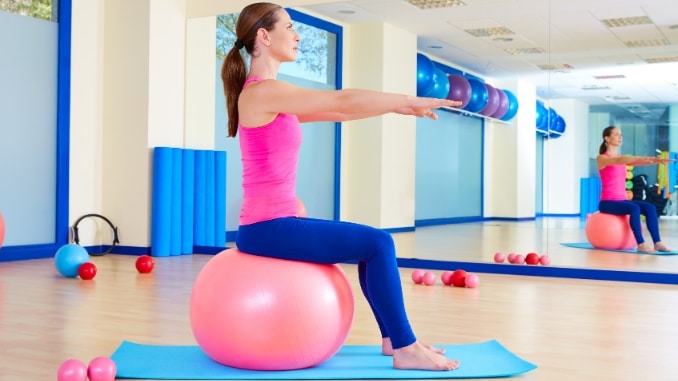
The incorporation of recovery, like Swiss ball recovery exercises, is a vital element in every fitness regimen. After pushing your body through intense workouts, giving your muscles and joints the time they need to repair and rebuild is crucial. Without proper recovery, you may experience decreased performance, increased risk of injury, and slower progress toward your fitness goals.
Post-exercise recovery involves a combination of rest, nutrition, and targeted exercises to aid recovery. While rest and nutrition are vital, incorporating specific recovery exercises into your routine can significantly enhance your body’s ability to bounce back and perform at its best. This is where Swiss ball recovery exercises come into play.
What is a Swiss Ball?
A Swiss ball, commonly known as an exercise ball or stability ball, is a big inflatable ball made of durable, flexible material used in various fitness routines and physical therapy programs. It comes in different sizes, typically 45 to 85 centimeters in diameter, and can be inflated to the desired firmness. Exercise balls are known for providing an unstable surface that challenges balance and engages core muscles, making them practical for improving strength, flexibility, and stability. They are commonly used in more advanced exercises such as core exercises, stretching, yoga, and Pilates in gyms and at home. They can even enhance the effectiveness of traditional exercises like the plank position.
These versatile fitness tools have gained popularity for their ability to offer a full-body workout, emphasizing enhancing core strength and promoting better posture. Swiss balls are a valuable addition to exercise routines for individuals looking to improve their physical fitness and overall well-being.
Benefits of Incorporating Swiss Ball Recovery Exercises
Swiss ball recovery exercises offer a range of benefits that make them a valuable addition to any post-workout routine. One of the primary advantages is their ability to alleviate muscle tension and reduce soreness. Using a Swiss ball, you can target specific muscle groups and apply gentle pressure to release tension and knots, promoting faster recovery.
Additionally, it improves flexibility, a crucial component of recovery. The deep stretches performed on a Swiss ball help elongate muscles and increase their range of motion. By improving flexibility, you enhance your body forms overall mobility and reduce the risk of injury during future workouts.
Another significant benefit of Swiss ball recovery exercises is the engagement and strengthening of abdominal muscles in your core. The unstable surface of the Swiss ball forces your core muscles to work harder to maintain stability and balance. Strengthening your core not only aids in recovering from workouts but also enhances your overall athletic performance.
Furthermore, Swiss ball recovery exercises offer various movements and positions that can be tailored to your unique needs and goals. Whether you want to focus on specific muscle groups, improve balance, or target problem areas, the versatility of Swiss ball exercises allows for a dynamic and personalized recovery routine.
Key Swiss Ball Recovery Exercises
Here are some of the key stability ball workouts that can help you regenerate and rejuvenate your body after strenuous physical activity.
Gentle Warm-Up
For this exercise, place one hand on a chair or wall for support if needed.
Begin in an upright sitting position on a stability ball with your knees bent and feet resting on the floor. Place one hand on a chair or against the wall for support if needed. Bring your legs straight in front of your body with your toes pointing toward the ceiling. Engage your core muscles and bend both knees to rock the stability ball forward. Straighten your legs to return to the starting position. Repeat the movement.
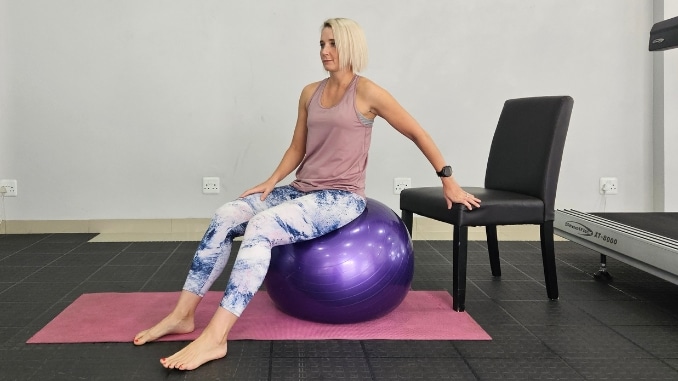 |
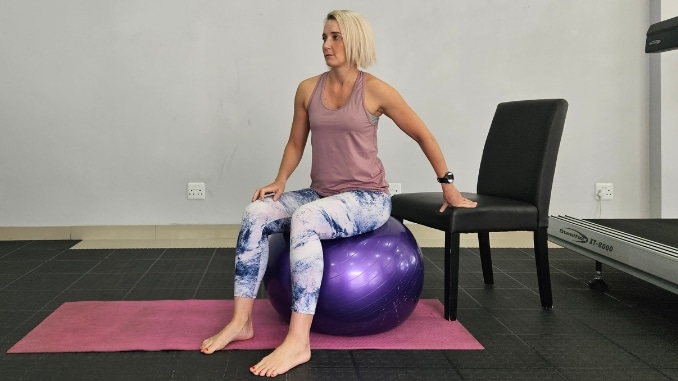 |
Routines
1. Chest Press
Begin in an upright sitting position on a stability ball, forming a straight line with your head, shoulders, and hips. Loop and hold the ends of the resistance band in each hand. Bring your arms in front at chest height with your elbows bent out to the sides, creating resistance on the band. Extend your legs in front of your body. Engage your core, and roll the ball forward by bending your knees as you extend your arms straight forward. Roll the stability ball back to the starting position by straightening your legs and pulling your arms back, contracting your shoulder blades. Repeat the sequence of movements. Start with 1 set of 10 repetitions.
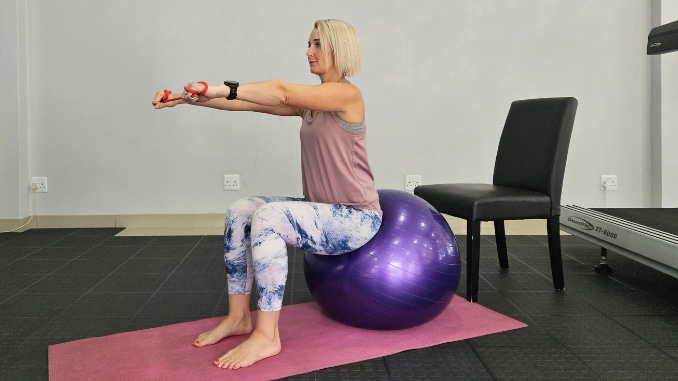 |
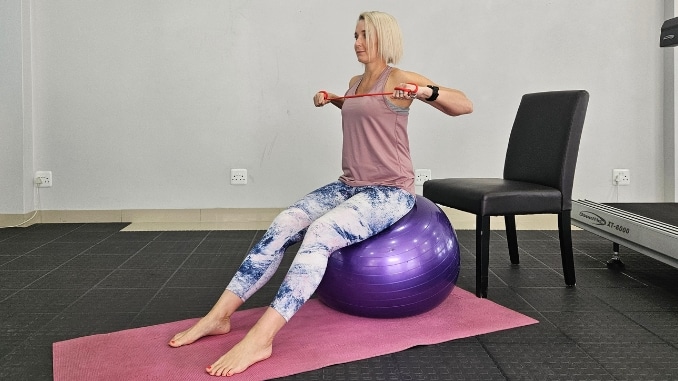 |
2. Seated Single Leg Lifts
For this exercise, utilize a chair, table, or any stable object for support if needed.
Begin in an upright sitting position on the stability ball with your knees bent and feet flat on the floor, maintaining good alignment in your upper body. Wrap the mini band around your thighs, just above your knees, and place your hand on the chair for support. Engage your core and lift one leg off the floor. Hold this position for a couple of seconds, then lower your foot back down to return to the starting position. Repeat the movement on the opposite leg. Start with 1 set of 10 repetitions on each side.
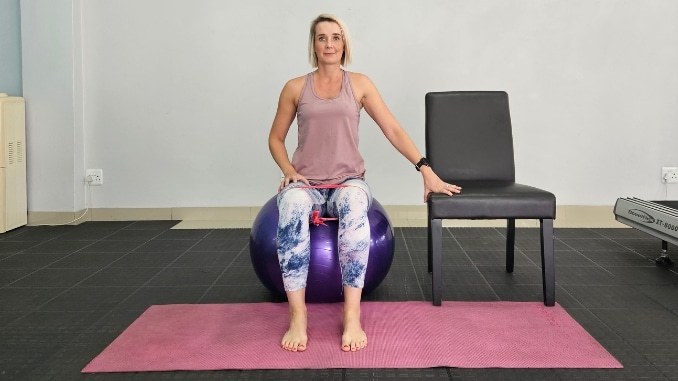 |
 |
To make the exercise more challenging, extend your arms out in front of your body as you lift your leg.
3. Leg Abduction
For this exercise, utilize the chair or wall for balance if needed.
Begin in an upright sitting position on the stability ball with your knees bent and feet flat on the floor, maintaining a good alignment in your upper body. Wrap the mini band around your thighs, just above your knees, engage your core, then pivot from your ankles to open your knees out to the sides. Bring your knees together to return to the starting position and repeat the movement. Start with 1 set of 10 repetitions.
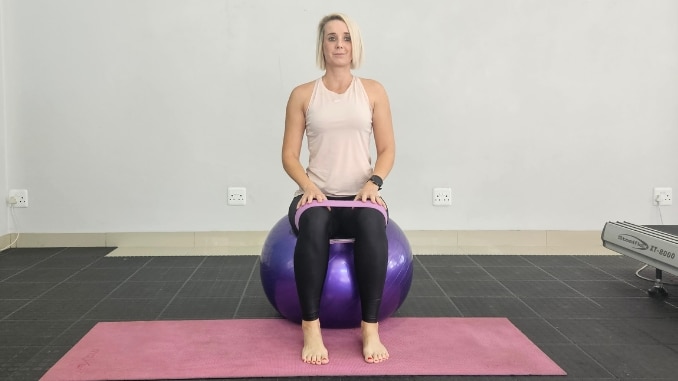 |
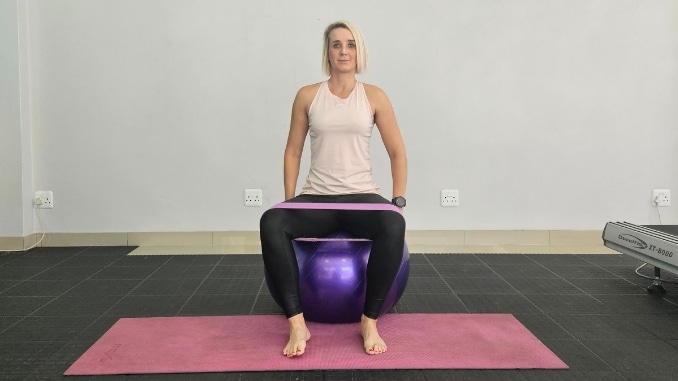 |
Note: To make the exercise more challenging, lift your toes on both feet as you go through the movement.
4. Seated Glute Lifts
For this exercise, utilize the chair, table, or any stable object for support if needed.
Begin in an upright sitting position on the stability ball with your knees bent and feet flat on the floor, maintaining good alignment in your upper body. Wrap the mini band around your thighs, just above your knees. Place your hands at your sides on the stability ball for support, then straighten one leg in front as you squeeze your glutes. Engage your core and straighten your arms to lift your seat slightly off the stability ball. Hold this position for a few seconds. Relax and lower your seat to the starting position. Repeat the movement on the opposite side. Start with 1 set of 5 repetitions on each side.
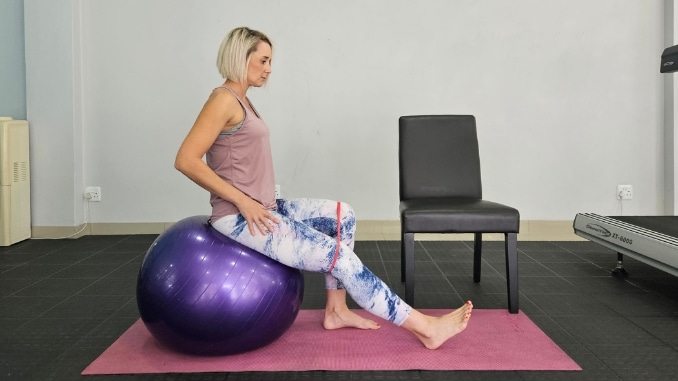 |
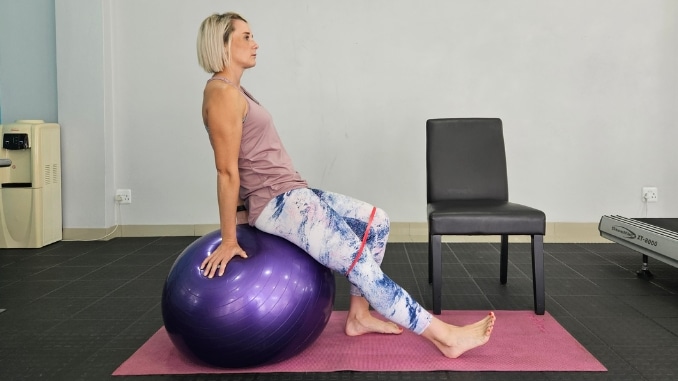 |
Note: To make the exercises easier, perform the movement with both of your knees bent.
Alternate Exercise – Lunges
For this exercise, utilize the chair, table, or any stable object for support and balance if needed.
Begin in an upright standing position, maintaining good alignment in your upper body. Place both hands on your hips, then step back with your left foot, and lower your back knee halfway to the ground to move into a lunge position. Engage your core and bend your front knee directly over your ankle. Hold the position for a couple of seconds. Return to the starting position and repeat the movement on the opposite side. Start with 1 set of 10 repetitions on each side.
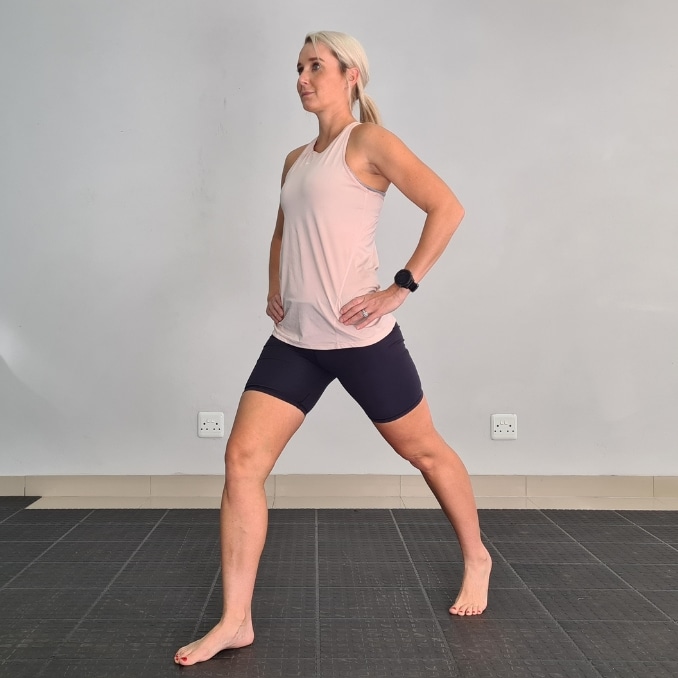 |
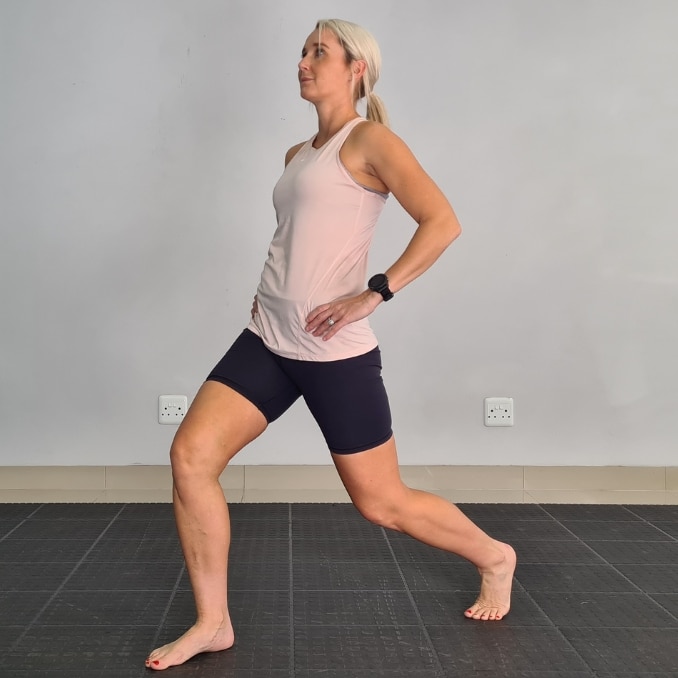 |
5. Ball Roll-Outs
For this exercise, utilize the chair, table, or any stable object for support and balance if needed.
Begin in an upright standing position in front of the stability ball with your feet shoulder-width apart, maintaining good alignment with your head, shoulders, hips, and legs. Wrap the mini band around your legs, just above your knees. Step one foot on top of the stability ball, creating resistance on the band. Hold onto the back of the chair with one hand for balance and your opposite hand on your bent knee. Engage your core, squeeze your glute, and straighten your leg, rolling the ball forward. Bend your leg to roll the ball to the starting position and repeat the movement. Start with 1 set of 10 repetitions on each side.
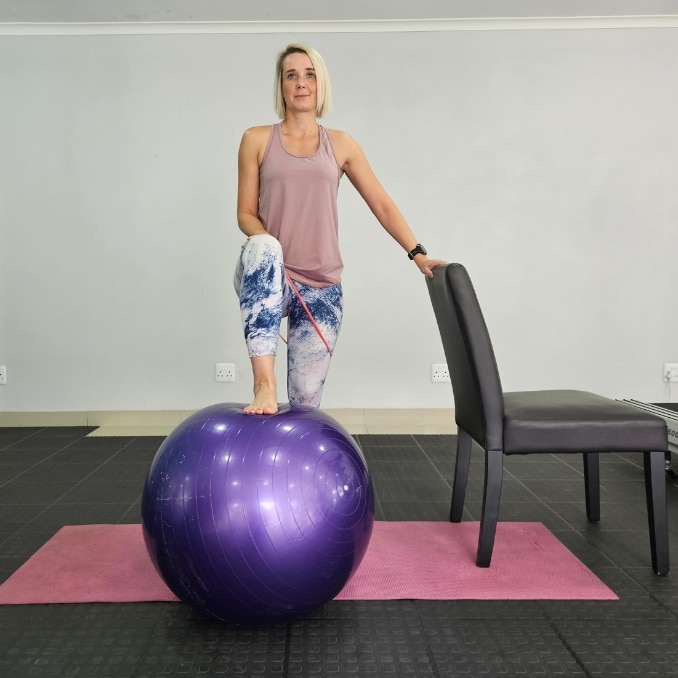 |
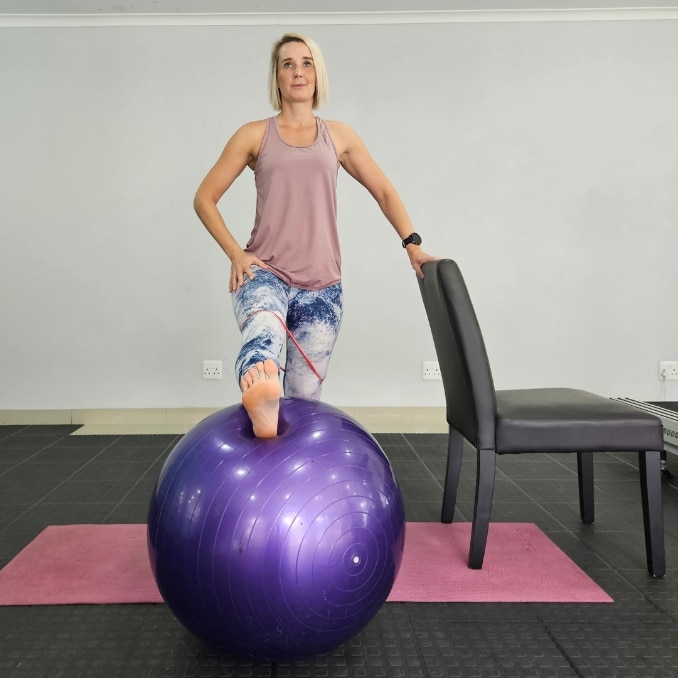 |
Note: Try doing this exercise without holding onto the chair to make the exercise more challenging.
Integrating Swiss Ball Recovery Exercises into Your Workout Routine
To incorporate Swiss ball recovery exercises into your workout routine effectively, consider the following suggestions:
- Post-workout routine: Perform Swiss ball recovery exercises immediately after your workouts to take advantage of the increased blood flow and warm muscles. This will help promote faster recovery and reduce post-exercise soreness.
- Active recovery days: Dedicate some of your workout time to Swiss ball recovery exercises on rest or active recovery days. Try concentrating only on recovery and give your body the attention it needs.
- Supplement to stretching: Use Swiss ball recovery exercises to supplement your regular stretching routine. The deep stretches performed on the Swiss ball can enhance the benefits of traditional static stretching and provide a more comprehensive recovery experience.
- Preventive measures: Incorporate Swiss ball recovery exercises to minimize the likelihood of getting injured. By regularly stretching and releasing tension in your muscles, you can minimize imbalances and promote proper muscle function.
Conclusion:
Incorporating Swiss ball recovery exercises into your post-workout routine significantly enhances your body’s recovery and overall performance. These exercises engage your core, relieve muscle tension, and improve flexibility, providing a comprehensive approach to recovery. They target specific muscle groups and facilitate deep stretching, effectively releasing tension and reducing soreness.
Moreover, various exercises enable a customized recovery regimen designed for your individual needs and objectives. It’s important to prioritize proper form, listen to your body, and progressively advance to more challenging exercises. Complement Swiss ball exercises with techniques like foam rolling, stretching, and rest to optimize post-exercise recovery.
Making Swiss ball recovery exercises a regular part of your fitness routine can elevate your recovery process, reduce the risk of injury, maximize your fitness gains, and ultimately, lead to a healthier and happier you.
Are the pain, stiffness, and decreased range of motion holding you back from exercising again when you want to? Don’t worry, help is here! Check out these Recovery Workouts now!




